|
|
|
Sort Order |
|
|
|
Items / Page
|
|
|
|
|
|
|
| Srl | Item |
| 1 |
ID:
128638
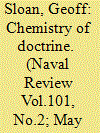

|
|
|
|
|
| Publication |
2013.
|
| Summary/Abstract |
The author, in a three part series examines the evolution of naval warfighting doctrine, with examples, and seeks to set out a grammar of doctrine.
Within the context of the present highly complex and shifting environment and in the face rapid technological change, it is not unreasonable to question the validity of doctrine - Albert Palazzo -2008
Knowing the enemy is the bedrock of the business of strategy: strategic theories in comparison, are second order problems. To concentrate on doctrine before enemies is to put the theoretical cart before the actual horse -a double error - Ken Booth, 1979
Doctrine is the box outside of which we need to think- Colonel Rory Copinger, Symes, Royal Marine-2010
|
|
|
|
|
|
|
|
|
|
|
|
|
|
|
|
| 2 |
ID:
128659
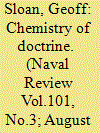

|
|
|
|
|
| Publication |
2013.
|
| Summary/Abstract |
In the second part of his series of articles, the author examines the development of naval doctrine through the 18th century, culminating in the production and publication of the fighting doctrine which informed the first world war, and governed the conduct of the battle of Jutland in 1916
|
|
|
|
|
|
|
|
|
|
|
|
|
|
|
|
| 3 |
ID:
128720
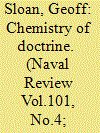

|
|
|
|
|
| Publication |
2013.
|
| Summary/Abstract |
In this the concluding part of his series on the chemistry of doctrine, the author examines the further evolution of naval doctrine during the second world war, with specific reference to the battle of Atlantic . He concludes by surveying the whole three part series and drawing some enduring lessons and principles.
|
|
|
|
|
|
|
|
|
|
|
|
|
|
|
|
| 4 |
ID:
133402
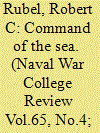

|
|
|
|
|
| Publication |
2012.
|
| Summary/Abstract |
the trade of the world commands the riches of the world and consequently the world itself. For in war . . . the common sense of some and the genius of others sees and properly applies means to ends; and naval strategy, like naval tactics, when boiled down, is simply the proper use of means to attain ends. But in peace, as in idleness, such matters drop out of mind, unless systematic provision is made for keeping them in view.
The last great sea battle occurred in 1944. Since then the world ocean has been open to free navigation by all nations as a matter of American policy. The ability to enforce this policy-or perhaps better said, the absence of serious challenges to this policy-has been in significant part a product of the superiority of the U.S. Navy. Despite a latent and partial challenge during the Cold War by the Soviet navy, since World War II the degree and persistence of U.S. Navy superiority have led most people to take it for granted and have caused the old term "command of the sea" virtually to disappear from the naval lexicon.1 However,
the emergence of a powerful Chinese navy and an associated land-based seadenial force is stimulating a new focus on sea control and overcoming antiaccess/ area-denial efforts. New concepts, such as "AirSea Battle," are being developed and investments made in platforms, weapons, and systems. This activity is critical to American strategic interests and prospects, and it must be informed by an understanding of command of the sea as a foundational concept of sea power. A reconsideration of command of the sea is all the more necessary as political, economic, and technological developments have significantly changed the nature of how sea power influences the dynamics of geopolitical interactions. This article will argue for an extended definition of the term and its renewed application to naval strategy and doctrine.
|
|
|
|
|
|
|
|
|
|
|
|
|
|
|
|
| 5 |
ID:
141512
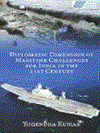

|
|
|
|
|
| Publication |
New Delhi, Pentagon Press, 2015.
|
| Description |
xii, 258p.hbk
|
| Standard Number |
9788182748538
|
|
|
|
|
|
|
|
|
|
|
|
Copies: C:1/I:0,R:0,Q:0
Circulation
| Accession# | Call# | Current Location | Status | Policy | Location |
| 058347 | 359.03054/KUM 058347 | Main | On Shelf | General | |
|
|
|
|
| 6 |
ID:
151425
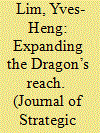

|
|
|
|
|
| Summary/Abstract |
Among the multiple dimensions of the tous azimuths modernisation of Chinese naval forces, the development of China’s anti-access capacity has recently elicited considerable interest. The important link between this capacity and an overarching vision of the use of force – i.e. a naval doctrine – has, however, often been left implicit. This article shows that the particular development of China’s naval anti-access forces – more precisely, forces with an impact on the naval balance – can be explained by a shift of China’s naval doctrine towards a distinctly pre-emptive posture, which, itself, stems from the set of constraints imposed by the framework of ‘local war under informationised conditions’.
|
|
|
|
|
|
|
|
|
|
|
|
|
|
|
|
| 7 |
ID:
132189
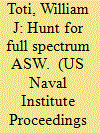

|
|
|
|
|
| Publication |
2014.
|
| Summary/Abstract |
An antisubmarine warfare doctrine adopted U.S. Navy-wide nearly a decade ago still applies, now more than ever.
During the Cold War, the U.S. Navy (particularly the submarine force) specialized in and excelled at antisubmarine warfare against the Soviet Union. But with the demise of the Soviets, ASW was put on the back-burner as an activity irrelevant to modern conflict. Over a decade passed before submarines would again be considered a serious threat to national security. During that time the nature of the submarine threat changed, so when the Navy "rediscovered" ASW, it learned that traditional, sensor-based methods of fighting against submarines, while important, could no longer ensure victory. To respond to this new threat, a new approach emerged in 2005, one that became known as "Full-Spectrum ASW." Quickly adopted as Navy doctrine, the concept pursued a more holistic approach to solving the submarine problem. This first-ever published treatise on the concept should explain how the doctrine was developed, in the hopes that a more thorough understanding of the concept will lead to better implementation.
|
|
|
|
|
|
|
|
|
|
|
|
|
|
|
|
| 8 |
ID:
098319
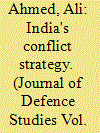

|
|
|
|
|
| Publication |
2010.
|
| Summary/Abstract |
Continued engagement with LOAC and IHL is ongoing with the Judge Advocates
General Department taking the primary role. Its training institution in Kamptee
is at the forefront. There has been increased interaction with the ICRC since
India opened up to the ICRC in the mid nineties, after initially being defensive
with respect to Kashmir. Not only has IHL been introduced into officer and
subordinate ranks courses, but guest lectures are also organised. Increased
scope of the engagement is possible, particularly if it finds mention in the next
edition of the Army doctrine. Increasing the scope of adherence to IHL, such as
by acceding to AP I and the ICC, can be debated. Even if India remains outside,
it can be expected that it would follow the tenets as a responsible power.
|
|
|
|
|
|
|
|
|
|
|
|
|
|
|
|
| 9 |
ID:
082455
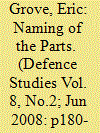

|
|
|
|
|
| Publication |
2008.
|
| Summary/Abstract |
This article examines a little-known part of Julian Corbett's
Some Principles
of Maritime Strategy
(1911), the 'Theory of the Means' and compares it to thecontemporary designations of British warships. These underwent great
change in 1887, being named according to the ship's function (e.g. 'battleships'
and 'cruisers') as opposed to the previous approach of naming them
according to technological characteristics. This decision resulted from
changes in technology and in naval doctrine and strategy. The article
discusses Corbett's views about the battleships and cruisers of his time, and
concludes that the modern Royal Navy could usefully return to his
approach of designating warships
|
|
|
|
|
|
|
|
|
|
|
|
|
|
|
|
| 10 |
ID:
179210
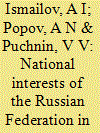

|
|
|
|
|
| Summary/Abstract |
This paper stems from an analysis of the Naval Doctrine of the Russian Federation, and of new risks, challenges and threats in order to specify the country's national interests in the Global Ocean and review the procedure of using state policy instruments for their defense.
|
|
|
|
|
|
|
|
|
|
|
|
|
|
|
|
| 11 |
ID:
064070
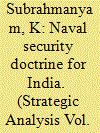

|
|
|
| 12 |
ID:
066364
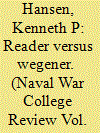

|
|
|
| 13 |
ID:
123937
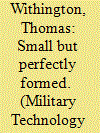

|
|
|
|
|
| Publication |
2013.
|
| Summary/Abstract |
The article reports on the modernization of the United Arab Emirates (UAE) Navy. The author claims that since its inception in the early 1970s, the UAE Navy has evolved into one of the best-equipped maritime forces in the world. He reports that missile-armed craft are replacing gun-armed surface combatants to provide defense to offshore oil installations. He states that the Navy occupies an important security provider position in the country, given its location and territorial disputes.
|
|
|
|
|
|
|
|
|
|
|
|
|
|
|
|
| 14 |
ID:
133063
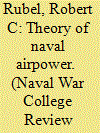

|
|
|
|
|
| Publication |
2014.
|
| Summary/Abstract |
The U.S. Navy has never been comfortable with theory or doctrine at what is now known as the operational level of war. The Navy has always possessed robust ship- and formation-level doctrine-tactics-and of course has embraced the high-level sea-power theories of both Alfred Thayer Mahan and Julian Corbett. The gap in the middle either has not been needed-as has been essentially the case for most of the Navy's history except for World War II-or has been filled by adaptive practice in the form of specific campaign or operations plans. For the Navy, the old framework of strategy and tactics has sufficed since 1945. However, an emergent set of circumstances in the form of Chinese naval development, as well as a new generation of weapons and sensors, is driving the Navy into incorporating the operational level into its culture. Moreover, this development is bringing the Navy into competition, or perhaps conflict, with the U.S. Air Force over which should exert operational control of aviation over the water. Whereas this task was always presumed to be the preserve of the Navy, the establishment in Hawaii of a regional Air Operations Center (AO C) that
in theory controls all air in the theater will challenge Navy assumptions and equities. The tactics of interservice squabbling aside, the Navy will need a theory of naval airpower as a foundation for its arguments to preserve operational control of its aviation.
|
|
|
|
|
|
|
|
|
|
|
|
|
|
|
|
|
|
|
|
|